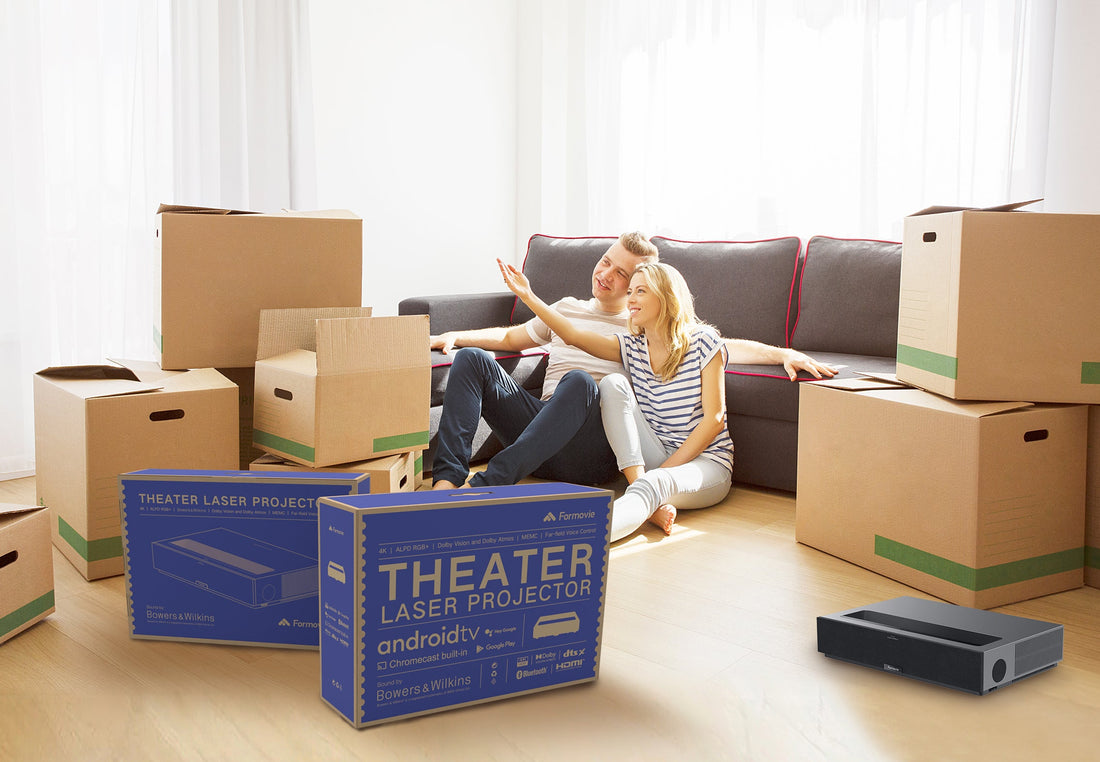Mastering Installation Distance and Screen Size for Ultra-Short Throw Projectors

Ultra-short throw projectors are a technological marvel that has redefined the way we interact with content by bringing larger-than-life visuals to even the most intimate of spaces, eliminating the constraints of traditional projectors. Unlike long-throw projectors, a UST projector can be placed closer to the screen to simultaneously eliminate the chance of shadows blocking the screen, and optimize your viewing experience with stunning displays and resolution.
As with all good things, there’s a little catch if you want to get the most out of a UST projector like the Formovie THEATER, it’s essential to calculate the perfect installation distance and screen size for your specific UST projector. In this blog, we’ll give a step-by-step breakdown of the whole process plus the specific factors that can influence the installation distance, making it easier for you to achieve the perfect home theater or conference room setup.
Understanding Installation Distance
The installation distance refers to the space between the projector and the display panel or screen. Ultra-short throw projectors are unique because they can display the same screen size as traditional projectors from a shorter distance, defying the need for ample space between the projector and the screen. The two key components that influence the installation distance are the projector’s throw ratio and the screen’s size. Together, the installation distance, throw ratio, and screen size can be used as a formula to create a breathtaking spectacle.
Screen Size
A simple rule to remember is that the desired screen size is the biggest factor that affects the installation distance. The larger you want the screen to be, the further the projector will need to be placed from the screen to get a sharp image. Opting for a smaller screen size gives you the liberty to move the projector closer, however, this distance will still be determined by the projector’s throw ratio.
Throw Ratio
The projector’s throw ratio indicates how wide the displayed image will be at any given distance. The number is often expressed as a ratio, with the first number representing the distance from the projector to the screen, and the second number indicating the width of the image. A low throw ratio signifies that the projector can work wonders from just a few centimeters away.
Calculating Installation Distance
As mentioned above, the screen width and projector’s throw ratio can be used in a formula to calculate the installation distance: Screen Width x Throw Ratio = Installation Distance. This means that to fit the projector's image within a 100-inch screen with an ultra-short throw ratio of 0.3:1, you’ll need to place the projector 30 inches away, or 100 x 0.3 = 30. Ensure that the projector is placed in a secure position with enough room to not hang over the edge.
Alternatively, you can use the same formula to determine the screen size from a fixed point like a preinstalled TV stand: Installation Distance / Throw Ratio = Screen Width. For example, if the only available position to place the projector is a mere 20 inches from the display panel, an ultra-short throw projector with a low throw distance of 0.23:1 like the Formovie THEATER can still grant you a large screen size of 87 inches (20 / 0.23 = 86.9), where a projector with a 0.3: throw ratio can only manage 67 inches (20 / 0.3 = 66.6)
To get a clearer understanding of the size and dimensions for the projector/screen ratio, check out the table below:

|
Screen Dimensions (SD) |
Relative Distance (D) |
Relative Height (H) |
|
80’’ |
14 cm |
30 cm |
|
90’’ |
18 cm |
34 cm |
|
100’’ |
23 cm |
37 cm |
|
120’’ |
33 cm |
43 cm |
|
150’’ |
49 cm |
50 cm |

- Screen Dimensions (SD): Diagonal size of the projection screen (in inches)
- Relative Distance (D): Distance between the projector and the wall or screen (in cm)
- Relative Height (H): Distance from the bottom of the projector to the bottom edge of the projected image (in cm)
- 1 cm = 0.393700787 inch
- diagonal² = height² + width²
- AR = width / height – aspect ratio
- Aspect Ratio of Formovie THEATER: 16:9
The screen dimension (SD) is determined by the distance of the projector from the wall (D) and the distance between the bottom edge of the screen and the bottom edge of the projected image, measured in height (H).
Other Factors to Consider
While the main factors to consider when determining the installation distance are screen size and throw ratio, some factors are unique to your entertainment space or projector that can affect your viewing pleasure.
Room Size
Bigger may be better, but ideally, you want to be able to see the whole screen. The size of the room in comparison to the overall size of your screen can sometimes mean that you need to scale down the size of your display to fully enjoy it. Sitting too close to the screen could turn out to be more of a visual strain than a viewing pleasure.
Wall or Screen Type
We previously explored how choosing the best screen for your entertainment area can completely elevate the viewing experience. A white wall or screen may be more than enough to get the best display from a standard or short-throw projector, however, a UST projector works best with an ambient light-rejecting (ALR) screen. Using any other screen will affect the way the projector performs.
Create an Enjoyable Viewing Experience
Armed with the knowledge to calculate installation distance and screen size, you’re well on your way to creating a viewing haven that is unique to you. By following the provided formulas, you can confidently set up your projector to fit your preferences whether it’s for a movie night or a presentation in the office.


